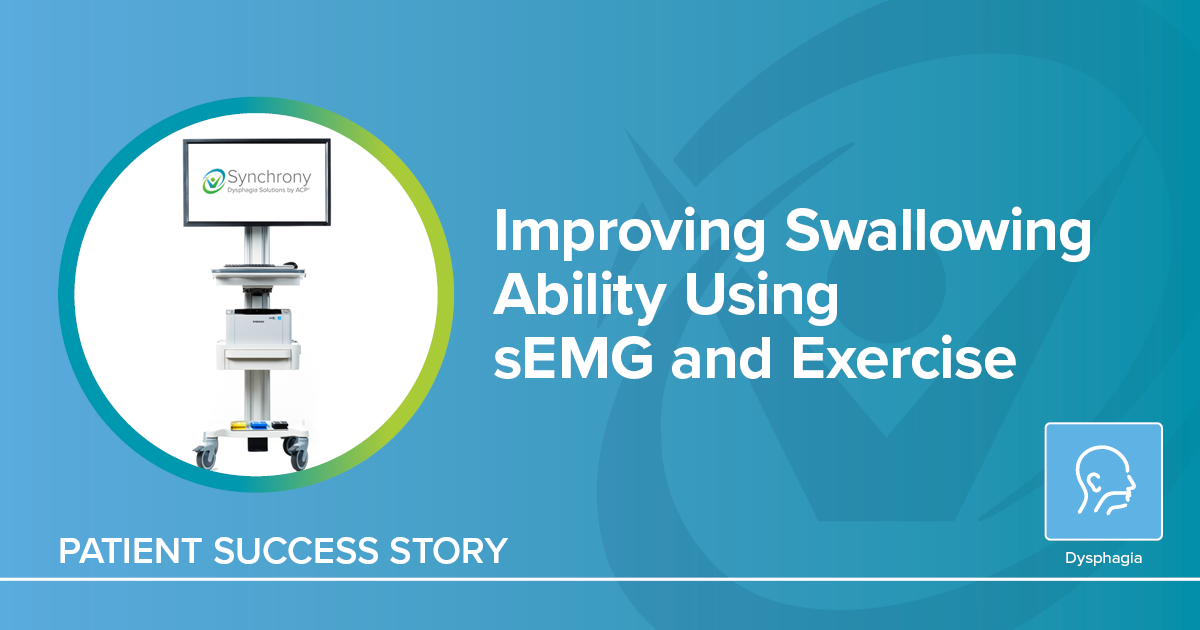
Patient Information: Female, Age 73
Diagnosis: Closed Head Injury / Intellectual Disability / Oropharyngeal Dysphagia
History: This woman, born with intellectual disability, was referred to a skilled nursing facility for rehabilitation services following hospitalization due to a fall at her group home, which resulted in a head injury and femur fracture. Prior to her fall, she lived in a group home with caregivers, was non-verbal, and consumed a regular diet with thin liquids. However, caregivers modified her diet to soft solids due to noted occasional difficulty in chewing and swallowing.
Pre-Therapy Status:
- Clinical Swallow Evaluation (CSE): Revealed loss of food and drink from mouth due to decreased labial (lip) strength, difficulty masticating (chewing) solid and soft foods, and frequent coughing with occasional gesturing to neck area, indicating “hurt” or pain.
- Instrumental Swallow Study: Video Fluoroscopy Swallow Study (VFSS) indicated aspiration (liquid or food entering into the lungs) of nectar thick liquid with inability to clear due to a weak cough. Also noted significant residue of honey thick liquid remaining in the throat following the swallow. These impairments occurred due to decreased lingual coordination with excessive tongue “pumping” and premature spillage of drink into the throat, and subsequently the airway.
- Functional Oral Intake Scale (FOIS): Level 4; total oral diet of a single consistency.
- Diet Level: Pureed diet with moderately thick (honey) liquids and medications crushed in puree.
Therapy Information:
- Modality: OmnisEMG™ Dysphagia System.
- Frequency: 5x per week.
- Protocol Specifics: Using OmnisEMG biofeedback, effortful swallows were performed with Bar Graph visualization to improve swallow effort and function. Mastication exercises were performed using Work/Rest Cycle visualization to increase oral preparation of regular textured foods.
- Duration: Four weeks.
- Other Therapy Services Provided: Verbal cueing of “close lips and swallow hard” to assist with adequate labial seal for reduced spillage and reminder to drink liquid after food in attempt to clear excess residue from throat.
Outcome:
- CSE: Improved labial function as noted by decreased anterior spillage of food and drinks, improved mastication efficiency, and no further coughing or tapping of neck to indicate pain.
- Instrumental Swallow Study: Fiberoptic Endoscopic Evaluation of Swallowing (FEES) revealed no aspiration with thin liquids or soft, bite-sized solids with adequate airway protection and decreased pharyngeal residue.
- FOIS: Level 6; total oral diet of multiple consistencies without special preparation but with specific food limitations.
- Diet Modification: Soft, bite-sized solids with thin liquids.
This woman is pleased she is able to drink thin liquids and eat solid food again! While in the hospital, she was told her swallowing deficits were not likely to improve. The SLP team reports the incorporation of Synchrony Dysphagia Solutions by ACP® program and use of the OmnisEMG™ was very beneficial in her rehabilitation. “The feedback and visualizations made it easy for this woman to understand when she achieved the goal for each swallow and provided engaging, motivating ways to complete the number of trials necessary for improvement.”
